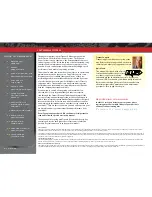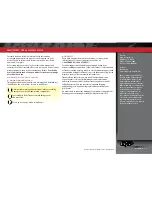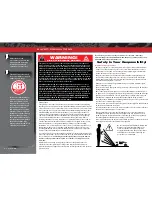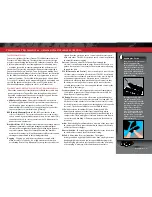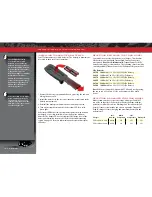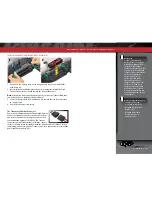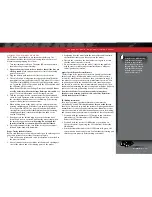
X-MAXX • 5
SAFETY PRECAUTIONS
• Keep the X-Maxx stored with the batteries removed, out of the reach of children and protected from access by
any other unauthorized driver.
• Always disconnect the batteries in the model when it is not in use. Never store the vehicle with batteries in the
model, as this can cause a fire leading to property damage, serious personal injury or even death.
• Do not continue to operate the model with low batteries or you could lose control of it. Indications of low
battery power include slow operation and delayed vehicle response. Stop immediately at the first sign of weak
batteries. When the batteries in the transmitter become weak, the red power light will begin to flash. Stop
immediately and install new batteries.
• Most importantly, use good common sense at all times.
Speed Control
Your model’s electronic speed control (ESC) is an extremely powerful electronic device capable of delivering
high current. Please closely follow these precautions to prevent damage to the speed control or other
components.
•
Disconnect the Battery:
Always disconnect the battery or batteries from the speed control when not in use.
•
Insulate the Wires:
Always insulate exposed wiring with heat shrink tubing to prevent short circuits.
•
Transmitter on First:
Switch on your transmitter first before switching on the speed control to prevent
runaways and erratic performance.
•
Don’t Get Burned:
The ESC and motor can become extremely hot during use, so be careful not to touch them
until they cool. Supply adequate airflow for cooling.
•
Use Traxxas High-Current Connectors:
Do not change the battery and motor connectors. Improper wiring can
cause fire or damage to the ESC. Please note that modified speed controls can be subject to a rewiring fee when
returned for service.
•
No Reverse Voltage:
The ESC is not protected against reverse polarity voltage.
•
No Schottky Diodes:
External Schottky diodes are not compatible with reversing speed controls. Using a
Schottky diode with your speed control will damage the ESC and void the warranty.
• Always adhere to the minimum and maximum limitations of the speed control as stated in the specifications
table in the Owner’s Manual. If your ESC operates on two batteries, do not mix battery types and capacities. Use
the same voltage and capacity for both batteries. Using mismatched battery packs could damage the batteries
and electronic speed control.
FIRE HAZARD! This vehicle requires LiPo batteries.
Charging and discharging batteries has the potential for
fire, explosion, serious injury, and property damage if
not performed per the instructions. In addition, Lithium
Polymer (LiPo) batteries pose a SEVERE risk of fire if not properly
handled per the instructions and require special care and handling
procedures for long life and safe operation. WARNING: LiPo batteries
are intended only for advanced users that are educated on the risks
associated with LiPo battery use. Traxxas does not recommend that
anyone under the age of 14 use or handle LiPo battery packs without
the supervision of a knowledgeable and responsible adult. Dispose of
used batteries according to the instructions.
• Your model requires the use of LiPo batteries. LiPo batteries have
a minimum safe discharge voltage threshold that should not be
exceeded. The electronic speed control is equipped with built-in
Low-Voltage Detection that alerts the driver when LiPo batteries have
reached their minimum voltage (discharge) threshold. It is the driver’s
responsibility to stop immediately to prevent the battery pack from
being discharged below its safe minimum threshold.
• Low-Voltage Detection is just one part of a comprehensive plan for
safe LiPo battery use. It is critical to follow all instructions for safe
and proper charging, use, and storage of LiPo batteries. Make sure
you understand how to use your LiPo batteries. If you have questions
about LiPo battery usage, please consult with your local hobby dealer
or contact the battery manufacturer. As a reminder, all batteries
should be recycled at the end of their useful life.
• DO NOT use a charger designed for NiMH or NiCad batteries.
Failure to use the correct charger may result in battery damage, fire,
personal injury, and/or property damage.
• The use of a NiMH or NiCad charger or charge mode will damage the
batteries and may cause fire and personal injury.
• ALWAYS inspect your LiPo batteries carefully before charging. Do not
use or charge battery packs that have been damaged in any way (bent,
dented, swollen, torn covering, or otherwise damaged).
• BEFORE you charge, ALWAYS confirm that the charger settings exactly
match the type (chemistry), specification, and configuration of the
battery to be charged. DO NOT exceed the maximum manufacturer
recommended charge rate. DO NOT attempt to charge non-rechargeable
batteries (explosion hazard), batteries that have an internal charge circuit
or a protection circuit, or batteries that have been altered from original
manufacturer configuration.
• While charging or discharging, ALWAYS place the battery (all types
of batteries) in a fire retardant/fire proof container and on a non-
flammable surface such as concrete.
• ALWAYS charge batteries in a well-ventilated area.
• Charge the battery in a safe area away from flammable materials.
Monitor the charging process and never leave batteries unattended
while charging. Do not allow small children to charge or handle LiPo
batteries.
• DO NOT disassemble, crush, short circuit, or expose the batteries to
flame or other source of ignition.
• DO NOT let any exposed battery contacts or wires touch each other.
This will cause the battery to short circuit and create the risk of fire.
• DO NOT leave the charger and battery unattended while charging,
discharging, or anytime the charger is ON with a battery connected. If
there are any signs of a malfunction, unplug the power source and/or
stop the charging process immediately.
• ALWAYS unplug the charger from the wall outlet and disconnect the
battery when not in use.
• Never charge LiPo battery packs in series or parallel. Charging packs in
series or parallel may result in improper charger cell recognition and an
improper charging rate that may lead to overcharging, cell imbalance,
cell damage and fire.
• If a battery gets hot to the touch during the charging process
(temperature greater than 110°F / 43°C), immediately disconnect the
battery from the charger and discontinue charging.
• DO NOT store or charge LiPo batteries with or around other batteries
or battery packs of any type, including other LiPos.
• Store and transport your LiPo batteries in a cool dry place. DO NOT
store in direct sunlight. DO NOT allow the storage temperature to
exceed 140°F or 60°C or the cells may be damaged and risk of fire
created. ALWAYS store battery packs safely out of the reach of children
and pets.
• Keep a Class D fire extinguisher nearby in case of fire.
• DO NOT disassemble LiPo batteries or cells. DO NOT disassemble the
charger.
• DO NOT attempt to build your own LiPo battery pack from loose cells.
• REMOVE the battery from your model or device before charging.
• DO NOT expose the charger to water or moisture.
WARNING! CAUTION! DANGER!


